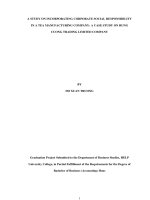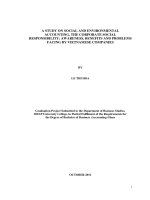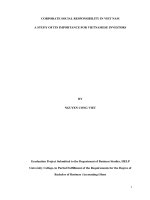CORPORATE SOCIAL RESPONSIBILITY (CSR) chapter 5
Bạn đang xem bản rút gọn của tài liệu. Xem và tải ngay bản đầy đủ của tài liệu tại đây (2.48 MB, 59 trang )
CORPORATE SOCIAL
RESPONSIBILITY (CSR)
Dr. Nguyễn Thị Vân Hà
Faculty of Business Administration
16/03/2013 | UTC | FET-DBA| Dr.Nguyen Thi Van Ha | ‹1›
Copyright by Dr. Nguyen Thi Van Ha
Course Structure
PART I: STRATEGIC CORPORATE SOCIAL
RESPONSIBILITY
Textbook and References
•
[1] William Werther and David
Chandler. (2011). Strategic Corporate
Social Responsibility (2nd edition).
California: SAGE publications, Inc
(Main book)
•
[2] David Crowther & Güler Aras
(2008).
Corporate
social
responsibility. Ventus Publishing ApS.
[3] Michel Capron & Françoise
Quairel-Lanoizelée (2009). Trách
nhiệm xã hội của doanh nghiệp. Nhà
xuất bản Tri thức (Dịch giả: Lê Minh
Tiến, Phạm Như Hồ)
[4] Phillip Kotler & Nancy Lee (2008),
Corporate Social Responsibility (2nd
edition), Wiley India Pvt. Ltd
(Reference book)
Chapter 1: What is Corporate Social
Responsibility?
Chapter 2: Corporate Strategy: A Stakeholder
Perspective
Chapter 3: How Much Does CSR Matter?
Chapter 4: The Strategic Context of CSR?
•
Chapter 5: Implementation: The integration of CSR
Into Strategy and Culture
PART II: CSR ISSUES AND CASE STUDIES
•
Chapter 6: Organizational Issues and Case Studes
Chapter 7: Economic Issues and Case Studies
Chapter 8: Societal Issues and Case Studes
16/03/2013 | UTC | FET-DBA| TS.Nguyen Thi Van Ha | ‹2›
Examination: Semi-multiple
Choice in 90 minutes
CHAPTER 5 – IMPLEMENTATION: THE
INTEGRATION OF CSR INTO STRATEGY AND
CULTURE
Chapter Five Outline
Introduction
The CSR threshold
•Variation among companies
•Variation among industries
•Variation among cultures
CSR- an integral aspect of the firm?
Implementation- short to medium term
Implementation- building CSR into the organizational culture
•From a strategic perspective: planning
•From a firm perspective: action
16/03/2013 | UTC | FET-DBA| TS.Nguyen Thi Van Ha | ‹3›
5.1 INTRODUCTION
• This chapter provides insights as to what a firm must do
to integrate strategic CSR into the organization’s
culture and actions.
• That is, when and how does a company become more
socially responsible?
• We address the when by focusing on the CSR threshold,
a tipping point that triggers firms to move toward strategic
CSR.
• Then we turn to the how by outlining the design, timing,
and implementation of strategic CSR, introducing the
necessary corporate infrastructure and key policy ideas.
16/03/2013 | UTC | FET-DBA| TS.Nguyen Thi Van Ha | ‹4›
5.2 THE CSR THRESHOLD
• The decision of when to implement a CSR policy is
compunded by why
why, where
where, how
how, and by whom it should be
implemented.
• The industry context complicates things further because of
the varied stages of acceptance of CSR by different
competitors.
• Although the value of an effective CSR policy within specific
industries and companies is becoming increasingly accepted,
the point at which such a policy becomes ripe for
implementation varies.
16/03/2013 | UTC | FET-DBA| TS.Nguyen Thi Van Ha | ‹5›
5.2 THE CSR THRESHOLD
• It varies with many factors, including:
• the industry,
• the current business environment,
• the CEO’s attitude toward CSR, and
• other factors.
• Companies can pursue an effective CSR policy for either
offensive or defensive reasons.
• On the offensive side, the innovative, proactive CEO who is
convinced of the intrinsic value of CSR sees it as an
opportunity that can maximize company capabilities and
identify new competitive advantages.
16/03/2013 | UTC | FET-DBA| TS.Nguyen Thi Van Ha | ‹6›
5.2 THE CSR THRESHOLD
Examples::
Examples
• Reduction of energy cost by innovative buiding design and
recycling policies (Nike case).
• Raise of morale and increase in retention through employee
volunteer programs which reduce training cost.
• Companies with a progressive and innovative mind-set
capable of designing and implementing effective CSR policies
see benefits, ranging from being an attractive employer
(helping retention and recruitment) to greater acceptance
among government agencies and social activists.
16/03/2013 | UTC | FET-DBA| TS.Nguyen Thi Van Ha | ‹7›
5.2 THE CSR THRESHOLD
• On the defensive side, CSR still has value for a company,
primarily by avoiding criticism and other attacks on the firm or
its offerings.
• In this instance, CSR acts like a brand insurance policy
policy,
minimizing or offsetting stakeholder
response to perceived lapses in CSR.
disillusionment
in
Either approach assumes an up-front investment in creating
CSR policies; however, when to introduce CSR into the
strategic process depends on the driving force behind its
implementation.
16/03/2013 | UTC | FET-DBA| TS.Nguyen Thi Van Ha | ‹8›
5.2 THE CSR THRESHOLD
• For those managers convinced of the potential benefits of
strategic CSR, there is no time like the present. Innovative
ideas and policies that maximize market opportunities,
minimize costs, and increase productivity can produce
immediate benefits.
• For managers yet to be persuaded of the argument for CSR
and reluctant to invest up front for potential future gains,
however, the temptation exists to look around at industry
competitors and delay as long as possible.
• Worse, cynical managers might see CSR as merely a public
relations exercise or, worse still, postpone hard CSR choices
by assuming they can avoid outlays for health insurance – a
risky, if not foolhardy, approach.
16/03/2013 | UTC | FET-DBA| TS.Nguyen Thi Van Ha | ‹9›
5.2 THE CSR THRESHOLD
• Neverthless, a crises point can arise. Once reached, and
stakeholder backlash becomes sufficient to warrant the
introduction of a reactionary CSR policy, it may be too late.
Summary:
Summary:
• Firms introduce CSR for different reasons.
• Implementing CSR proactively throughout the firm generates
the business benefits listed above and may yield additional
benefits associated with first-mover status.
• The genuine implementation of CSR, whether for offensive or
defensive reasons, generates the insurance-like benefits,
which render CSR lapses less damaging if committed due to
factors outside the firm’s control.
16/03/2013 | UTC | FET-DBA| TS.Nguyen Thi Van Ha | ‹10›
5.2 THE CSR THRESHOLD
• Whatever the motivation, however, there is a CSR threshold
in every industry that acts as a last-resort, CSR point of no
return.
• The sooner the CSR is introduced, the less likely a firm is to
cross this “tipping point,” which varies for each company
(depending on whether it is the market leader or a small
player) and within each industry (some industries are more
suspectical to stakeholder backlash than others).
• The variable nature of this CSR threshold suggests why some
companies perceive CSR to be of greater or lesser
importance to their particular organization.
16/03/2013 | UTC | FET-DBA| TS.Nguyen Thi Van Ha | ‹11›
5.2 THE CSR THRESHOLD
Question::
Question
Why different companies and industries have different CSR
thresholds for different reasons?
Answer::
Answer
The business-level strategy a company pursues is key to
answering this question.
16/03/2013 | UTC | FET-DBA| TS.Nguyen Thi Van Ha | ‹12›
5.2 THE CSR THRESHOLD
The CSR Threshold – Variations Between
Companies
• Analyzing a company’s business-level strategy
reveals how it distinguishes itself in the marketplace.
• Its value proposition is captured in its strategy and
attracts stakeholder groups, particularly customers.
• In turn, strategy has a direct impact on the CSR
threshold for that company within its industry.
value proposition: (in marketing) an innovation, service , or
feature intended to make a company or product attractive to
customers.
16/03/2013 | UTC | FET-DBA| TS.Nguyen Thi Van Ha | ‹13›
5.2 THE CSR THRESHOLD
Figure 5.1: The BusinessLevel CSR Threshold
Competitive Advantage
Focused
Differentiation
Niche
Focused
Cost
Leadership
Niche
Focused
Differentiation
Broad
Competitive Scope
Cost
Cost
Differentiation
16/03/2013 | UTC | FET-DBA| TS.Nguyen Thi Van Ha | ‹14›
5.2 THE CSR THRESHOLD
Let’s consider these comparisons using Figure 5.1:
• WalMart’s cost strategy probably raises the company’s CSR
threshold; that is it has more CSR leeway and can “get away
with” more because its value proposition is based on low cost.
So, paying low wages to its workers is not surprising for a
Walmart customer.
• For Body Shop (which built its reputation and customer base on
social justice – e.g. no animal testing), the CSR threshold at
which customers, media, and society in general react may have
a much lower tipping point.
• Thus, The Body Shop’s stakeholders are more likely to have a
lower threshold of tolerance for perceived CSR violations.
16/03/2013 | UTC | FET-DBA| TS.Nguyen Thi Van Ha | ‹15›
5.2 THE CSR THRESHOLD
• As Figure 5.1 shows, business-level strategies can be
divided into those pursuing low costs and those
pursuing differentiation
differentiation.
• The low-cost approach suggests an ability to deliver
products or services at a price below that of
competitors.
• For example, Walmart gains its competitive
advantage from its “everyday low prices.”
• Differentiation strategies, however, seek to offer the
customer something unique, such as a luxury car
from Rolls Royce.
16/03/2013 | UTC | FET-DBA| TS.Nguyen Thi Van Ha | ‹16›
5.2 THE CSR THRESHOLD
• The low-cost differentiation strategies can be further categorized
as either broad (e.g., wide product range) or narrowly focused
(e.g., pursuing only high-end cars, but not SUVs, station
vagons, or pickup trucks).
• As a result, Walmart has a scope of business that can be labeled
broad, while Rolls Royce’s offerings are focused
broad
focused.
• Overall, therefore, Rolls Royce’s business strategy offers a
differentiated products, focused on the niche market of high-end
cars, whereas Walmart’s strategy pursues cost leadership (low
costs) accross a broad base of customers.
• McDonald’s however seeks a focused strategy of low cost (cheap
food) and differentiation (fast service).
16/03/2013 | UTC | FET-DBA| TS.Nguyen Thi Van Ha | ‹17›
5.2 THE CSR THRESHOLD
• Whether a company pursues a cost- or differentiation-based
strategy shapes the firm’s CSR threshold (the point at which
CSR becomes obviously critical to strategic success).
• The most vulnerable strategy will be focused differentiation,
particularly for those products dependent on lifestyle
segmentation, such as products targeted at specific customers
based on their approach to life.
Example:
Example:
• Nike tries to associate its products with people who have a
positive and pysically active lifestyle.
• If Nike is seen as socially irresponsible by its target customers,
they are less likely to want to associate their lifestyle with these
products.
16/03/2013 | UTC | FET-DBA| TS.Nguyen Thi Van Ha | ‹18›
5.2 THE CSR THRESHOLD
• Market segments, or niches, such as lifestyle brands,
are especially valuable to a company because they
often rest more heavily on subjective impressions
(fashion) as opposed to objective price and quality
comparisons.
• Moreover, customers who associate the brand’s
appeal with their lifestyle are often willing to pay a
greater premium for the product.
• Yet, paradoxically, those able to pay this premium
are precisely those with the widest range of
alternatives, backed by the resources to make
different choices.
16/03/2013 | UTC | FET-DBA| TS.Nguyen Thi Van Ha | ‹19›
5.2 THE CSR THRESHOLD
• Thus, a CSR-related failure that might inflict limited
harm on a firm relying on a broad, cost-based
strategy could prove significantly damaging to one
reliant on a strategy of focused differentiation.
• The petrolium industry offers another example. The
nature of this industry allows ExxonMobil to adopt a
lower CSR profile than either BP or Shell without
penalty.
• This implies a higher CSR threshold for ExxonMobil
because it has both lower visibility among
environmentalists and its products are hardly
differentiated from etiher BP’s or Shell’s.
16/03/2013 | UTC | FET-DBA| TS.Nguyen Thi Van Ha | ‹20›
5.2 THE CSR THRESHOLD
• As different companies range accross the Figure 5.1
(in the direction of the shaded arrow) from cost- to
differentiation-based strategies, the CSR threshold
that they face is likely to fall, making those firms
more susceptible to stakeholder backlash.
• This, therefore, increases the importance of an
effective and well-implemented CSR policy within the
firm.
• A similar tendency is visible when analyzing the
industries within which these firms operate.
16/03/2013 | UTC | FET-DBA| TS.Nguyen Thi Van Ha | ‹21›
5.2 THE CSR THRESHOLD
The CSR Threshold – Variations Between Industries
• Different industries also evoke different stakeholder emotions.
Example:
• A company operating within the apparel (clothing) industry
(with its reputation for sweatshop labor in developing countries)
may face a higher CSR threshold if it sells unbranded clothing
based on low cost.
• But the CSR threshold may drop dramatically for a company
using a focused diferentiation strategy that offers a “lifestyle
brand” aimed at well-to-do customers who have choices and
include more than just cost in their value calculations.
16/03/2013 | UTC | FET-DBA| TS.Nguyen Thi Van Ha | ‹22›
5.2 THE CSR THRESHOLD
• If a well-known fashion brand is seen as violating
CSR expectations, customers can quickly abandon
the brand and products by shopping elsewhere.
• But a large nonbranded producer, particularly one
offering just low-cost styles, may have a much higher
threshold, simply because the connection between
product, brand, and customer aspirations is weaker.
• By comparison, in the financal or banking industry
(with strategy of broad differentiation), the CSR
threshold may be relatively higher than for apparel.
16/03/2013 | UTC | FET-DBA| TS.Nguyen Thi Van Ha | ‹23›
5.2 THE CSR THRESHOLD
• Here, it may be harder for consumers to identify a victim or
accurately quantify the degree of harm caused by any CSR
violation.
• The issues that determine the CSR threshold for an industry
seem more complicated than those for individual compaies, with
specific industries being more vulnerable than others.
• Indeed, a number of industries have already passed their CSR
threshold, which has forced companies operating within those
industries to take significant corrective action.
Examples:
• fast-food industry talking about benefits of health foods.
• Tobacco companies warning against dangers of smoking in it
advertising campaigns.
16/03/2013 | UTC | FET-DBA| TS.Nguyen Thi Van Ha | ‹24›
5.2 THE CSR THRESHOLD
The CSR Threshold – Variations Between Cultures
• CRS threshold driven by different cultural
expectations among different societies complicate the
picture.
Example:
• In USA, legal action determined the CSR thresholds
for the tobacco and fast-food industies.
• In Europe, it is NGO and nonprofit activism that has
largely driven the CSR agenda.
• In much of the developing world, however, the
perception of CSR revolves around issues of
corporate philanthropy.
16/03/2013 | UTC | FET-DBA| TS.Nguyen Thi Van Ha | ‹25›









